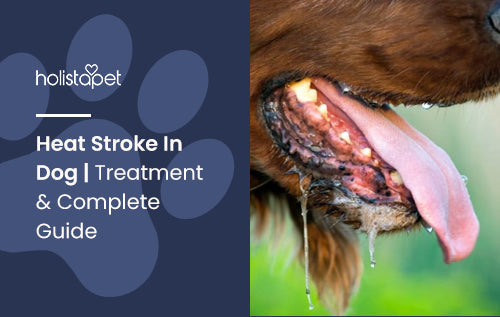A dog is usually unaware of the heat that could cause a stroke if pushed beyond their limits. They're just happy to be going with you on a walk or Sunday hike in the mountains. It's up to us to make sure our furry friends don't remain in the heat for too long or overexert themselves.
There are signs to look out for and natural ways to keep your pet healthy and prevent them from experiencing health problems due to heat exhaustion. If not handled properly, heat exhaustion can lead to other serious conditions. Read on to learn more about what causes this reaction in our dogs and what measures you can take to prevent it.
What is Heat Stroke in Dogs?
Hyperthermia, more commonly known as heat stroke, happens when a canine's body temperature elevates to dangerous levels. If your dog's body temperature reaches 103°F (39.4°C) or above, it becomes abnormal or hyperthermic.
When your pet reaches 106°F (41°F) or higher, with no underlying or previous illness, it is almost always associated with excessive external exposure or environmental heat. Temperature situations above these levels are what may lead to a stroke.
This happens when your pet's body can no longer accommodate or regulate the high temperature it has reached. Dogs don't sweat out excess body heat the way humans do. They have a few sweat glands in their paws that don't regulate body temperature the way rapid, open-mouthed breathing or panting does.
Panting is a dog's primary way of regulating its temperature and cooling down. When the danger zone level temperatures are reached, a dog's organs will begin to shut down and his heart is at risk of stopping altogether. Recognizing the signs and when you could be exposing your dog to high temperatures are the first steps to keeping your dog cool and healthy.

What Causes Heat Stroke?
The most common causes of hyperthermia in a dog are leaving them in an environment without enough ventilation, such as in a sealed car on a hot day. Extreme heat and cramped spaces can elevate a dog's temperature quite rapidly.
There are other situations that can lead to stroke, like leaving your dog exposed on a hot day for an extended period, without any shade or cold water. A lack of access to cool water or high exposure to a hairdryer may also lead to a stroke.
Some of the more underestimated ways include an over-excited or over-exercised dog. Humidity and environmental temperatures may not seem hot, but the rising temperature can creep up on your distracted furry friend, like during a midday walk. Some breeds are definitely more prone to heat exhaustion than others.
Are Some Breeds Prone to Heat Stroke?
For more or less obvious reasons, different dog breeds can be more likely to react to high temperatures than others. Here are some breeds, traits, and other factors that can cause a dogs temperature to rise a little faster than average:
Brachycephalic Breeds
Affectionately called the Brachys, these include all the breeds with short, flat noses and wide skulls. They are very prone to getting hot quickly. This includes breeds like French Bulldogs, Bulldogs, Boston terriers, Pekingese, Shi Tzus, and Pugs. Unfortunately, their unique faces restrict airflow by crowding the soft tissues, tongue, and cartilage, restricting airflow. These dogs are recommended to stay in cool temperatures regularly to maintain temperature and breath easily because clinical heat stroke can occur even in mildly high temperatures.
Hyper or Active Dogs
Breeds including Golden Retrievers, Border Collies, Spaniels, and Labradors, are classified as working or hunting dogs. They are hyper and enjoy playing/working out in the sun, so you may not see the signs until they collapse. Make sure these dogs take breaks often and continuously have access to cool water because they won't know when to call it quits for themselves. Monitor them closely for overheating and make sure they have some shade to rest under.

Coat Type
If you walk out to the August heat in a long, thick coat, chances are you'll start dripping in sweat and want to tear off that bulky thing in minutes. Some dogs have to deal with this feeling with their own coats (that they can't tear off). Breeds with dark, long, or thick coats may start to heat up faster than other pups. Darker coats will absorb more heat, and breeds such as Huskies and American Eskimos need to be kept cool and monitored carefully during the summer months. Some Husky owners have taken to social media to show how they fill plastic pools full of ice for their pooch to play in and beat the heat.
Weight or Age
Overweight dogs will undoubtedly face more health issues, and therefore, have a higher risk of heat exhaustion. This study of dogs who were treated for heatstroke showed that obesity essentially tripled the risk of death. The added layers of fat can act as insulation and slow the ability to regulate body temperatures. If your pet is very old or young, they can be exposed at a higher rate because the body cannot help itself or react appropriately.
How Do You Know if Your Dog is Having a Heat Stroke?
It may be tricky sometimes to figure out whether or not your pet is experiencing heatstroke symptoms, but there are some subtle and more precise signs to look out for.
Fever: Because fever is associated with a high temperature, the best way to know how high their temperature is, is by checking their rectal temperature. If it exceeds 105 degrees Fahrenheit, you should contact your vet immediately. Anything above 103 degrees indicates the system is heating up. This is the best way to get the most accurate temp of your dog.
Bleeding: Hyperthermia causes the body to stop producing the proteins it needs to make the blood clot, which exposes the body to bacteria and toxins. A dog with heatstroke can experience uncontrolled bloody diarrhea or bleeding from any body surface if it should become severe.
Loud Panting: As mentioned, your furry friend uses panting as a method of cooling, meaning that if it becomes really loud, harsh, and intense, this could be another sign of a stroke. Panting can often be associated with an excess amount of drooling, which is your dog’s way of releasing the extra heat. A high heart rate and a quickly expanding chest can accompany these symptoms. Checking a dog's respiratory rate depends on the breed, so ask your vet what is considered normal for your dog.
RELATED: Why Is My Dog Panting? [All Possible Reasons]
Strange Behavior: In some situations, your pet will collapse with no warnings, but sometimes, there will be strange behavior associated with heat exhaustion. Dogs with heatstroke will wander away instead of towards you when you call, act disoriented, or stagger about as if they're in a stupor. They may even start convulsing. This is definitely a time to take action.
How Fast Can a Dog Get Heat Stroke?
If your dogs have started experiencing some of the traits above or are within the age frames mentioned, they are certainly more prone to reaching higher body temperatures. In some situations, a dog's body temperature can elevate very rapidly, often within minutes.

Treatment for Heat Stroke in Dogs
If your dog is showing signs of heat exhaustion, move them to a cooler area immediately. Try to provide a space with air conditioning or a fan. Then follow these steps:
- Check their temperature. Heat exhaustion happens anywhere from 103 to 106 degrees Fahrenheit. Anything 103 degrees and above places them at risk for a heat stroke.
- Let's say you don't have a body of water for them to take a dip in. Then you can use a hose to wet them down (use cool water, but not too cold). Another method is to gently pat them with a wet, cool towel.
- To cool off the system internally, get the dog to drink some cool water. Don't force your dog to drink if they refuse. You can also try enticing them with ice cubes.
- Call your vet in case the steps above show no signs of improvement.
Related article: CBD treats for dogs
When Should You Go to the Vet?
You should go to the vet if you see anything above mild symptoms of heatstroke or no signs of improvement. Anything above 103 degrees Fahrenheit should be monitored. If the body rises above 106 it's time for an urgent trip to the vet. High temperatures put your dog's life at risk and should be seen immediately to treat and avoid long-term complications or death. Remember to pay attention, especially on hot days, or when your little buddy is highly active. Watch for any signs and monitor your pet's exertion levels.







![Probiotics For Dogs [Soft Chews] - HolistaPet](http://www.holistapet.com/cdn/shop/files/Probiotic-Infographic-1_472d7a29-e30c-435a-9638-1365d8c3a9f9.jpg?v=1725384841&width=104)



























Leave a comment
All comments are moderated before being published.
This site is protected by hCaptcha and the hCaptcha Privacy Policy and Terms of Service apply.